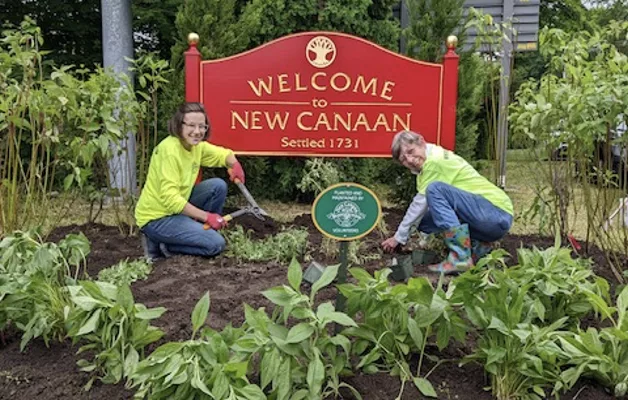By Peter Barhydt
First Selectman Dionna Carlson is steering New Canaan toward a leaner, more strategically managed future, using her annual Chamber of Commerce breakfast address on March 26 to outline a slate of initiatives that reflect tighter fiscal oversight, infrastructure investment, and a measured response to business community concerns.
Speaking to a packed room of merchants and civic leaders, Carlson offered a pragmatic snapshot of town operations while signaling continuity with her campaign message of responsible stewardship. “We’ve had many years of shiny toys,” she said, noting past capital investments. “Now it’s time to stick to our knitting.”
The town’s proposed $181 million budget marks a 3.56% increase from the previous fiscal year, with a 4.35% rise in revenue from taxation. The Board of Education’s portion accounts for a 4.4% jump in its operating budget, while the town’s own operating expenses are slated to grow by 3.73%. The most significant budgetary shift is a 23% increase in debt service, triggered by a recent $35 million bond issuance to fund the new police headquarters.
Carlson framed these figures not as warnings, but as calls to focus. “We’re being watched closely by Moody’s and our rating agencies,” she said. “It’s time to examine every dollar we spend.”
In tandem with fiscal caution, Carlson unveiled a carefully calibrated set of projects meant to improve downtown efficiency without compromising commercial vitality. Key among them is the introduction of paid parking on Elm Street—75 spaces will become paid parking spaces, replacing the current free-parking model. Park Street parking, in contrast, will become free. Carlson described the move as one rooted in logic, not revenue.
“Our most valuable real estate has been given away for free, while less desirable spots have been monetized,” she said. “We’re flipping that dynamic to improve flow and access.”
Pushback from longtime business owners followed. Concerns ranged from potential deterrence of quick-stop shoppers to fears of increased double parking. Carlson acknowledged these anxieties but positioned the plan as a trial, not a fait accompli. She also emphasized the potential for short-term parking accommodations, better signage, and improved app-based systems to ease the transition.
Parking commission member Katie O’Neill cited the success of 15-minute parking zones on Main Street as a possible template. “Turnover is the goal,” she said. “We want people to come, shop, and go—not circle endlessly or stay parked all day.”
Carlson’s willingness to adapt was a recurring theme. “Change is difficult,” she said. “But we’ll make course corrections as needed.”
Meanwhile, the town will proceed with long-planned bump outs at four Elm Street intersections. The work, expected to last three to four weeks, will reclaim five parking spots lost to earlier redesigns and enhance pedestrian safety. Carlson and Director of Public Works Tiger Mann committed to limiting disruption by phasing construction and keeping at least one lane open throughout.
That project is part of a broader infrastructure timeline, including the repaving of Elm Street in August and the installation of a 36-inch Aquarion water main down South Avenue. The latter, a state-driven initiative to service Greenwich, will close a portion of South Avenue to non-local traffic for two summers. “We don’t benefit directly,” Carlson said, “but we’re coordinating communication to keep the public and local businesses informed.”
On transit, Carlson noted that while no major updates have been received from Metro-North, she is pressing for information and welcomes feedback, especially after last year’s elimination of the 12:20 p.m. train.
The presentation also included updates on outdoor dining regulations—now beginning May 1 through the first Sunday in November—and a renewed focus on downtown branding through non-commercial banners and signage.
For business owners concerned about timing and coordination of projects, Carlson encouraged direct communication and reiterated her goal: a more walkable, efficient, and commercially vibrant downtown that works for residents, visitors, and merchants alike.
“We’re building a better-functioning town,” she said. “That takes listening, adjustment, and long-term thinking.”



